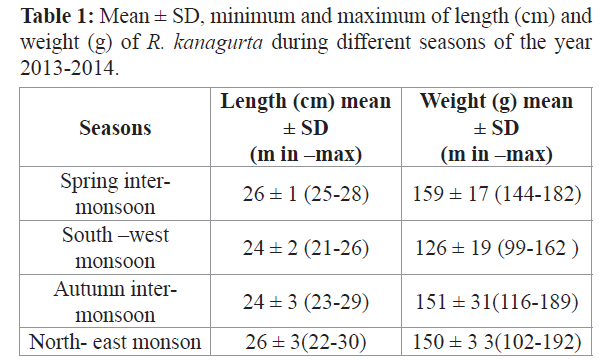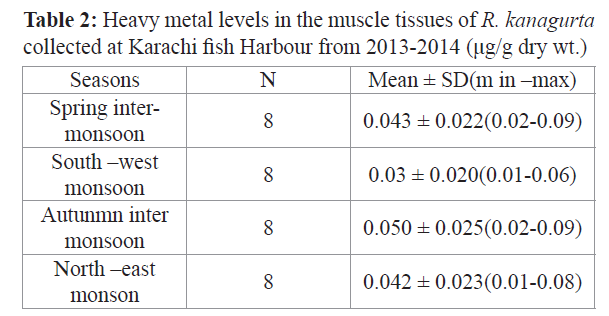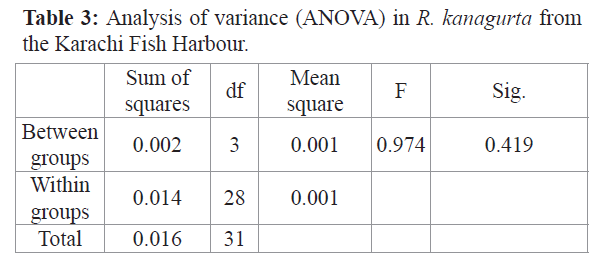Keywords
Mercury, Rastrelliger kanagurta, bio-indicator, Karachi Fish Harbour Pakistan
Introduction
The increasing use of the domestic and agricultural drainages and waste chemicals represents the most dangerous pollution in the marine coast. The pollution of marine ecosystems by heavy metals especially non-essentials is an important environmental problem as they constitute some of the most hazardous substances that can be up-taken and accumulated by marine organisms. Karachi coast of Pakistan is exposed to pollution associated pollutants including heavy metals from agricultural run-off from various point and non-point sources (Saleem and Kazi, G.H., 1998; Ahmed et al., 2015; Although Elahi et al., 2015). The most important heavy metal from the point of view of marine coastal pollution is Hg which has no known biological function. It is nonessential trace metal to living organisms and toxic at even low concentrations. Hg is one of the heavy metals of current interest in environmental contamination studies since the appearance in Japan of Minamata disease in the 1950s. It was used as a catalyst in the production of acetaldehyde, a chemical employed in the production of plastics. Methylmercury-contaminated wastewater, a by-product of the process, was pumped into the bay, increasing highly in the coast that accumulated local fish. Local people of Minamata, who consumed heavily on fish for food, were at risk of exposure to methylmercury led to severe neurological damage and died more than 900 people. Moreover approximately two million people from the area suffered health problems (McCurry, 2006). Owing to the common occurrence of Hg in industrial effluents, its extreme toxic properties to human and its existence in coastal waters as a potential pollutant, Hg has caused increasing alarm. It is highly toxic to a wide variety of living organism including man (Khansari et al., 2005) and is considered hazardous to human health at concentrations above 1 mg/kg (U.S. Food and Drug Administration, 2014). The U.S. Environmental Protection Agency (EPA) recommends safe levels for fish should not exceed 0.30 mg/kg. The consumption of fish should not be completely eliminated because of important healthy diet. Khansari et al. (2005) emphasized that fish are the single largest sources of Hg for man. Clarkson and Magos (2006) pointed out that Hg vapour is emitted to the atmosphere from anthropogenic and natural sources. Anthropogenic sources include emissions mainly from coal-burning power plants and municipal incinerators. Natural sources include volcanoes, rocks, soils and water surfaces. However, fish as biomonitor have been used for many years to indicate metal pollution in marine environment (Sucman et al., 2006). Fish has health benefits and is good source of protein, vitamin B and omega-3-fatty acids. It should be kept in mind that the health benefits of consuming fish outweigh the potential risks.
This study focuses on the Indian mackerel Rastrelliger kanagurta which is highly commercial fish and is consumed fresh, frozen, canned, dried-salted, smoked and even as a fish sauce (Collette, 2001). R. kanagurta (Cuvier, 1816) is pelagicneritic and oceanodromous fish (Riede, 2004). Adult individuals occur in coastal bays, harbours and deep lagoons, usually in some turbid plankton-rich waters (Collette, 2001). They have been known to feed on a variety of organisms, mainly phytoplankton (diatoms), small zooplankton especially cladocerans, ostracods, larval polychaetes (Collette, 2001) and macroplankton such as larval shrimps and fish (Collette, 1986). Thus these organisms are in contact with heavy metals including Hg in the water column and sediments. The dietary uptake of Hg is therefore an important exposure route possibly allowing metal biomagnification up trophic levels in the Indian mackerel R. kanagurta. The purposes of the present study were to determine if Hg is present in R. kanagurta from the most important fishing harbour of Karachi, Pakistan and to compare the concentrations of Hg present with the previous studies and the guidelines set down by the international organisations and Commission Regulation (EC) for the safe consumption limits of fish.
Materials and Methods
R. kanagurta were collected at Karachi Harbour monthly between March 2013 and February 2014. Obtained fish were placed in plastic bags and transported to the laboratory in freezer bags with ice. Total body length (cm) and weight (g) were recorded for fishes. Eight individuals from each season were chosen and were rinsed in clean sea water and then placed in plastic bags and frozen at -21°C until their analysis. The muscle tissues of the fish were prepared for analysis according to the method described by Bernhard (1976). Two gram homogenate samples of dorsal muscles of each fish samples were placed into the crucibles and were dried in furnace at 600ºC temperature for 3 hours and then dry ash were weighted in digital balance. These ashes were digested in the flasks containing 10 ml of concentrated HCl. When the digestions were completed, the solutions were cooled to ambient temperature and the digest was filtered and made up to 100 ml in a volumetric flask using ultrapure water as the diluent. The analysis for total mercury was performed on Mercury Hydride system (cold vapour Technique) Atomic Absorption Spectrometer. The AA Analyst 700 atomic absorption spectrometer with 253.7 wavelengths was used to determine Hg concentration in tissue samples of the fish and the results were given as mg/kg dry weight. The heavy metal analyses in the fish samples were recorded as means ± standard deviation (SD). Statistical analysis (ANOVA) was performed to test the differences between seasons and Tukey test was used to determine the differences (Zar, 1984). The weekly intake levels were estimated using the maximum Hg levels in R. kanagurta EWI (Estimated Weekly Intakes) = maximum level of Hg (mg/ kg) multiplied by fish consumption (kg/70 kg body weight/week).
Results and Discussion
The mean lengths (cm) and weights (g) of R. kanagurta from Karachi Harbour between March 2013 and February 2014 was given in Table 1. The lengths and weights of collected fish samples ranged from 21 to 30 cm and 99 to 192 g, respectively. The fish samples were consumable (market) size. In this study Hg levels in the Indian mackerel ranged from 0.01 to 0.09 mg/kg dry wt. (Table 2). Hg enters the food web when it is absorbed by phytoplankton species. Phytoplankton are eaten by zooplankton and other consumers, which then are eaten by larger and larger fish (Griesbauer, 2007). R. kanagurta feed on mainly phytoplankton (diatoms), small zooplankton especially cladocerans, ostracods, larval polychaetes (Collette, 2001) and macroplankton such as larval shrimps and fish (Collette, 1986). There was no statistically significant difference between the concentrations of the metals among seasons (P>0.05; F=0.974). However the total mercury levels in the samples was highest in the autumn inter- monsoon, followed by spring inter- monsoon, North-east monsoon and Southwest monsoon. It may be suggested that these variations of Hg levels in R. kanagurta are attributed to physiological conditions, environmental variations and feeding activity. The apparent high Hg levels in the muscle tissues of the Indian mackerel is likely due to food web transfer into surface waters through the upwelling of phytoplankton rich waters that was occurring during the autumn inter- monsoon.

Table 1: Mean ± SD, minimum and maximum of length (cm) and weight (g) of R. kanagurta during different seasons of the year 2013-2014.

Table 2: Heavy metal levels in the muscle tissues of R. kanagurta collected at Karachi fish Harbour from 2013-2014 (μg/g dry wt.)

Table 3: Analysis of variance (ANOVA) in R. kanagurta from the Karachi Fish Harbour.
The observed Hg values (0.01-0.09 mg/kg dry wt.) in R. kanagurta of the present study were lower than Bay of Bengal, India (Mukherjee and Bhupander 2011) and North East Coast of India (Kumar et al., 2012). This might be partly related to the fact that the surface water of Indian coasts contains a relatively large amount of Hg. The highest value of Hg (1.60 mg/kg) found in R. kanagurta within six marine species from north eastern Bay of Bengal, India (Mukherjee and Bhupander, 2011). Similarly, Kumar et al. (2012) determined high concentrations (ranged from 0.27 to 9.50 and the mean ±SE 1.22±0.20 mg/kg dry wt.) of Hg from North East coast of India. These data are in agreement with data from previous studies (Kamaruzzaman et al., 2010; Rejomon et al., 2010) evidencing that R. kanagurta has been widely used as bio-indicators of marine pollution by heavy metals.
Shah et al. (2010) have reported high Hg concentrations (0.721-1.41 mg/kg on dry wt.) in muscle tissues of Scombermorus commersoni, Otolithes ruber, Pampus argenteus and Arius spp. from fish markets of Karachi. Jinadasa et al. (2010) have also found high concentrations of Hg in the muscle tissues of Thunnus albacores (0.14-0.88 mg/kg wet wt.), Xiphias gladius (0.20-2.58 mg/kg wet wt.) and Lutjanus sp. (0.09-0.28 mg/kg wet wt.) from the local fish market of Sri Lanka. The highest Hg levels (3.97 ± 2.67 mg/kg dry wt.) were noted in X. gladius as top predators of pelagic food webs, caught in waters surrounding Reunion Island of the western Indian Ocean and it is suggested that large fish naturally bio-accumulate Hg and this can pose health risks to the fish themselves and to their predators, including humans (Kojadinovic et al., 2006). These data showed that Hg can be used as biomarker for water pollution which the contents of the metal in the tissues of the fish.
The results of this study revealed that consuming R. kanagurta from the Karachi fish Harbour may not have harmful effects because Hg levels in edible tissues are below the permissible limits. Moreover, comparisons with the European Union, Russian Federation food standards, Georgian standards, Chine standards, Australia New Zealand food standards and Turkish acceptable limit (0.5 mg/kg wet wt.) (Commission Regulations, 2001 and 2006; GAIN Report, 2002 and 2006; Georgian Food Safety Rules, 2001; Australia New Zealand Food Standards, 2011; TGK, 2002 and 2009), demonstrate that the content of these metals in the muscle tissue of the Indian mackerel is lower than the guidelines mentioned above.
JECFA has in 1978/1988 established a PTWI at 0.005 mg/ kg body weight for Hg, however, with a maximum at 0.0033 mg/kg body weight for methyl Hg (Council of Europe, 2001). Considering an average adult body weight of 70 kg (EPA, 1994), they are equivalent to 0.35 and 0.231 mg/week for an adult, respectively. By using the means of weekly fish consumption in Pakistan of 35 g per person (FAO, 2010) and the maximum Hg levels in muscle tissues of R. kanagurta, weekly intake calculated ranged from 0.001±0.0007 mg (35 g x 0.031±0.020 mg/1000 g) in South-west monsoon to 0.002±0.0009 mg (35 g x 0.050±0.025 mg/1000 g) in the autumn inter- monsoon between March 2013 and February 2014. It can be concluded from the results so far obtained that Hg content of fish collected in Pakistan is likely to allowable without human health effects.
Conclusion
Mercury is one of the most dangerous chemicals and is prone to accumulate in aquatic biota due to reduced biodegradation of its derivatives. It is concluded that smaller fish that are lower down in the food web have lower Hg levels in their tissues while larger one that are higher up in the food web have higher levels (Griesbauer, 2007). Thus, fish are extensively used as bio-monitors for assessing heavy metal contamination of coastal areas and the health state of marine ecosystems. The Hg level in R. kanagurta is relatively lower than those in other studies. The results of the present study were compared with the international legislations valid in the European Union. It was indicated that the Hg levels did not exceed the permission limits (0.5 mg/kg) and the Indian mackerel from Pakistan coast is consumed without any danger to health.
5822
References
- Ahmed, Q., Bat, L., Yousuf, F., (2015). Accumulation of heavymetals in tissues of long tail tuna from Karachi Fish Harbour,Pakistan. Aquatic Science and Technology, 3 (1): 103-115.doi: 10.5296/ast.v3i1.6814
- nAustralia New Zealand Food Standards, (2011).Contaminants andNatural Toxicants. Code - Standard 1.4.1 - Federal Registerof Legislative Instruments F2011C00542, Issue 124. https://www.comlaw.gov.au/Details/F2011C00542 accessed on06.06.2014
- nBernhard, M., (1976).Manual of Methods in the AquaticEnvironment Research. FAO Fisheries Technical Paper
- nClarkson, T.W., Magos, L., (2006). The toxicology of mercuryand its chemical compounds.Critical Reviews in Toxicology,36(8): 609-662
- nCollette, B.B., (1986). Scombridae (including Thunnidae,Scomberomoridae, Asterochismatidae and Sardidae). p.981-997. In P.J.P. Whitehead, M.-L. Bauchot, J.-C.Hureau,J. Nielsen and E. Tortonese (eds.) Fishes of the north-easternAtlantic and the Mediterranean, Volume 2. Unesco, Paris
- nCollette, B.B., (2001). Scombridae.Tunas (also, albacore, bonitos,mackerels, seerfishes, and wahoo). p. 3721-3756. In K.E
- nCarpenter and V. Niem (eds.) FAO species identificationguide for fishery purposes.The living marine resources of theWestern Central Pacific.Vol. 6.Bony fishes part 4 (Labridaeto Latimeriidae), estuarine crocodiles. FAO, Rome
- nCouncil of Europe, (2001). Council of Europe’s policy statementsconcerning materials and articles intended to come intocontact with foodstuffs. Policy Statement concerningmaterials and alloys.Technical Document.Guidelineson metals and alloys used as food contact materials.(09.03.2001), 67 pp., Strasbourg
- nEC (COMMISSION REGULATION) No 466/2001 of 8 March2001 setting maximum levels for certain contaminants infoodstuffs
- nEC (COMMISSION REGULATION) No 1881/2006 of 19December 2006 setting maximum levels for certaincontaminants in foodstuffs
- nElahi, N., Ahmed, Q., Bat, L., Yousuf, F., (2015). Physicochemicalparameters and seasonal variation of coastal water fromBalochistan coast, Pakistan. Journal of Coastal Life Medicine,3(3): 199-203. doi: 10.12980/JCLM.3.201514J94
- nEPA, (1994).Guidance for assessing chemical contaminant datafor use in fish advisories.Volume II. Risk assessment andfish consumption limits. Tech. rep., U.S. EnvironmentalProtection Agency, Office of Water, Philadelphia, PA
- nFAO, (2010). Statistics Division, Food Security Statistics, FoodConsumption
- nGAIN (Global Agriculture Information Network) Report,(2002).Russian Federation Sanitary/ Phytosanitary/ FoodSafety Russian Sanitary Rules and Norms.GAIN Report#RS2010.SanPiN-96.USDA Foreign Agricultural Service.Gossanepidnadzor Department of the Ministry of PublicHealth Care of Russia
- nGAIN (Global Agriculture Information Network) Report, (2006).China, Peoples Republic of FAIRS Product SpecificMaximum Levels of Contaminants in Foods. GAIN ReportNumber: CH6064. USDA Foreign Agricultural Service.Issued by the Ministry of Hygienic and the StandardizationAdministration of China
- nGeorgian Food Safety Rules, (2001). Fish, other river/sea productsand products made from them. SanPiN-2.3.2.560-96. TheMinister's Decree 16/08/2001 N301/n for Health, Labourand Social Affairs
- nGriesbauer, L., (2007). Methylmercury contamination in fishand shellfish.CSA Discovery Guides 9 pages.Availableat: https://www.csa.com/discoveryguides/discoveryguidesmain .php
- nJinadasa, B.K.K.K., Rameesha, L.R.S., Edirisinghe, E.M.R.K.B.,Rathnayake, R.M.U.S.K., (2010). Mercury, cadmium andlead levels in three commercially important marine fishspecies of in Sri Lanka.Sri Lanka J. Aquat. Sci., 15: 39-43
- nKamaruzzaman, B.Y., Ong, M.C., Rina, S.Z., (2010).Concentration of Zn, Cu and Pb in some selected marinefishes of the Pahang Coastal Waters, Malaysia. AmericanJournal of Applied Sciences,7(3): 309-314
- nKhansari, F.E., Ghazi-Khansari, M., Abdollahi, M., (2005).Heavy metals content of canned tuna fish. Food Chemistry,93: 293–296. doi: 10.1016/j.foodchem.2004.09.025
- nKojadinovic, J., Potier, M., Corre, M.L., Cosson, R., Bustamante,P., (2006).Mercury content in commercial pelagic fish andits risk assessment in the Western Indian Ocean.Science ofthe Total Environment, 366(2-3): 688-700
- nKumar, B., Sajwan, K.S., Mukherjee, D.P., (2012). Distributionof heavy metals in valuable coastal fishes from North EastCoast of India.Turkish Journal of Fisheries and AquaticSciences, 12: 81-88. doi: 10.4194/1303-2712-v12_1_10
- nMukherjee, D.P., Bhupander, K., (2011). Assessment of arsenic,cadmium and mercury level in commonly consumedcoastal fishes from Bay of Bengal, India. Food Science andQuality Management, 2: 19-30
- nRejomon, G., Nair, M., Joseph, T., (2010). Trace metal dynamicsin fishes from the southwest coast of India. Environ. Monit.Assess.,167(1-4): 243-255
- nRiede, K., (2004). Global register of migratory species – fromglobal to regional scales.Final Report of the R&D-Projekt808 05 081.Federal Agency for Nature Conservation, Bonn,Germany.329 p
- nShah, A.Q., Kazi, T.G., Baig, J.A., Afridi, H.I., Kandhro,G.A., Khan, S., Kolachi, N.F., Wadhwa, S.K.. (2010)
- nDetermination of total mercury in muscle tissues of marinefish species by ultrasonic assisted extraction followed bycold vapor atomic absorption apectrometry.Pak. J. Anal.Environ. Chem., 11 (2): 12-17
- nSaleem, M., Kazi, G.H., (1998).Concentration and distributionof heavy metals (lead, cadmium, chromium, copper, nickel,zinc) in Karachi shore and offshore sediments.PakistanJournal Marine Science.,7:71-79
- nSucman, E., Vávrová, M., Gargošová, H.Z., Mahrová, M.,(2006) "Fish – Useful Bio-Indicators For Evaluation OfContamination In Water Ecosystems," Proceedings of theAnnual International Conference on Soils, Sediments, Waterand Energy: 11: Article 3. Available at: https://scholarworks.umass.edu/soilsproceedings/vol11/iss1/3
- nTGK, (2002).Official Gazette of Republic of Turkey.Notificationsabout determination of the maximum levels for certaincontaminants in foodstuffs of Turkish Food Codex (inTurkish). (Notification No: 2002/63), Issue: 24885
- nTGK, (2008).Official Gazette of Republic of Turkey.Notificationsabout maximum levels for certain contaminants in foodstuffs(in Turkish). Turkish Food Codex No 2008 / 26, Issue:26879
- nU. S. Food and Drug Administration (FDA) Consumer, (2014).Mercury and Methylmercury.https://www.fda.gov/Food
- nZar, J.H., (1984). Biostatistical analysis.Second edition. PrenticeHall, Int., New Jersey.









